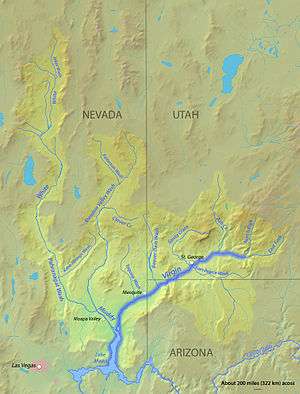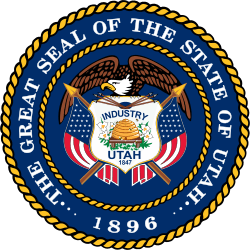Dixie (Utah)
Utah's Dixie is the nickname for the moderately populated, lower elevation area of south-central Washington County in southwestern Utah. Its climate is very mild when compared to the rest of Utah, and typical of the Mojave Desert, in which it lies. Situated below the Black Ridge and the Hurricane Cliffs, in the northeastern edge of the Mojave Desert, it was originally a part of Mexico and settled by the Southern Paiutes. It was first inhabited by Mormon settlers in 1854, as part of Brigham Young's efforts to establish an Indian Mission in the region.[1] The settlers began growing cotton and other temperate cash crops during the later 1850s. The Paiute population, that had been displaced by the new settlers, began to decline due to diseases that the Mormons brought and exposed to them.[2][3] The largest community in the region, St. George, was founded in 1861,[4] when Brigham Young selected 300 families to take over the area and grow cotton, grapes, and other crops.[4]:3 The region was nicknamed Dixie by 1860.

Andrew Larson's [5] text on the history of the name "Dixie" in Utah states that in 1857, the first President of the Washington Stake was Robert Dockery Covington, a slave overseer and slave owner from North Carolina and Mississippi. Larson states:
Already the settled area of the Virgin Valley was being called Utah's "Dixie." The fact that cotton would grow there, as well as tobacco and other semi-tropical plants such as the South produced made it easy for the name to stick. The fact that the settlers at Washington were bona fide Southerners who were steeped in the lore of cotton culture—many of them, at least—clinched the title. Dixie it became, and Dixie it remained. ... The name "Dixie" is one of those distinctive things about this part of Utah ... It is a proud title
— Andrew Larson, I Was Called to "Dixie" (p. 185) [Emphasis in original]
Whatever the real origins of the term, the Cotton Mission didn't work out as well as Young had hoped – yields in the test fields were not as high as expected, and economic viability of growing cotton was never achieved, although a cotton mill was built and used for a few years in the town of Washington.[6]
The largest city in the area is St. George, with a population of nearly 150,000 in the metropolitan area.[7]
See also
References
- Bradshaw, Hazel; Jenson, Nellie (1978) [1950]. Under Dixie Sun: a History of Washington County. Daughters of Utah Pioneers Washington County Chapter. p. 23. OCLC 4831960.
- Utah History To Go, American Indians, Paiutes from historytogo.utah.gov accessed December 4, 2015
- Arrington, Leonard J. (August 1956). "The Mormon Cotton Mission in Southern Utah". Pacific Historical Review. 25 (3): 221–238. JSTOR 3637013.
- Logue, Larry M. (1988). A Sermon in the Desert: Belief and Behavior in Early St. George, Utah. Urbana: University of Illinois Press. ISBN 025201474X. OCLC 16709942.
- Larson, Andrew (1992). I Was Called to "Dixie:" The Virgin River Basin: Unique Experiences on Mormon Pioneering. Dixie College Foundation St. George, Utah. p. 185.
- "Washington Cotton Factory". http://wchsutah.org. Washington County Historical Society. Retrieved November 12, 2013. External link in
|website=(help) - suburbanstats.org. "Current Washington County, Utah Population, Demographics and stats in 2016, 2017". SuburbanStats.org. Retrieved October 27, 2017.
Further reading
- Bleak, James Godson; Snow, William J; Reid, H Lorenzo (1928), Annals of the Southern Utah Mission, OCLC 43290460
